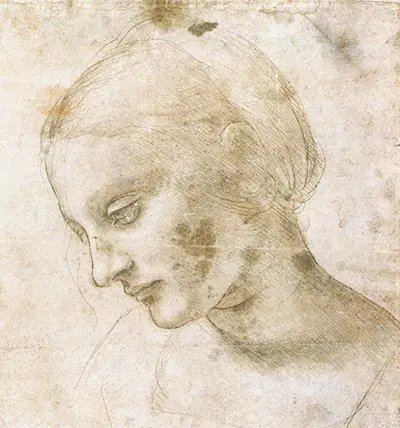Views of others then slowly began to change during the Renaissance - prior to this they were seen solely as wives and mothers and not individuals in their own right.
The images he created of women suggested to society that there was more to the female race than they appreciated.
This image, created c.1490, is entitled simply Study of a Woman’s Head. It is widely considered to have been the preparatory study that led to his painting of the Madonna Litta, a painting depicting the Virgin Mary breastfeeding the Christ child, which is now held in the Hermitage Museum, Saint Petersburg.
On the reverse of the image, a tracing of the women’s profile has been made, evidencing that this image may have been used as a teaching aid in one of Leonardo’s workshops.
The drawing was made with metalpoint on a greyish-green buff prepared paper. Metalpoint is a medium that was hugely popular in the fifteenth century.
The ancestor of the humble pencil, metalpoint was, as suggested by the name, a rod of metal shaped with a point at the end. The metal used could be lead, copper, gold or silver, although silverpoint was most commonly used as it was left the most permanent markings, producing a hard, clearly defined line.
The surface of the paper had to be treated with gesso or glue, and the metal rod was used to cut into the surface to create the image. Light and shade was formed by using repetitive lines, or hatching.
Da Vinci was innovative for his time in his desire to ensure his subjects appeared realistic. Making use of his own scientific studies of light and shadow, he set about producing images that were three-dimensional rather than the flat images that previous generations of artists had created.
His study of objects from a scientific viewpoint also showed him that an object’s colour and detail changed at a distance. He worked using a technique called Sfumato, originally developed by Venetian and Flemish painters, and this, along with his use of light and shadow, gave his portraits an atmosphere and depth to them.
Da Vinci himself instructed that to fully appreciate the beauty of a woman's face, muscles must not be drawn with hard lines. Soft light and pleasant shadows will bestow grace and beauty upon the face. He also taught that women should be painted with their heads looking downwards and leaning a little to the side.
This is an attitude he rarely gave to his male subjects.The series of heads of women also illustrate his love of hair, which he always painted great attention to detail, with tresses either flowing loose or confined under headdresses with soft, wispy tendrils breaking free.



